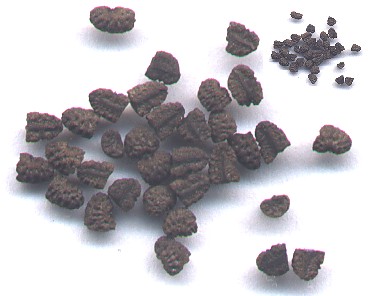Commelina communis (Commelinaceae)
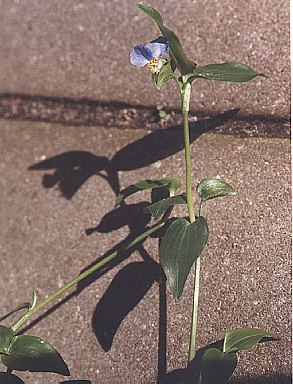
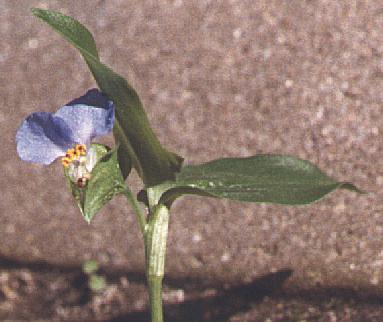
|
Dit "onkruid" met opvallend helderblauwe maar heel kleine bloempjes (die nauwelijks een dag bloeien) groeit in subtropische streken, als een kruipend gewasje dat in zijn groeistijl wel enige overeenkomst vertoont met onze muur-soorten,
hoewel daar beslist niet aan verwant. De foto's hierboven en hier vlak onder zijn van een exemplaar dat uit KroatiŽ afkomstig was (1983), en die daaronder komen van Madeira (1987). Hoewel ik destijds de indruk had met
twee verschillende planten te maken te hebben (die van Madeira is lichtbehaard, die van KroatiŽ glad), denk ik dat er hooguit een verschil in subspecies (ondersoort) bestaat. In huis gekweekt heb ik de Madeirese variant een winter overgehouden, maar de Kroatische niet. Die kweekte ik buiten, en die zaaide zichzelf, zodat ik de indruk had dat het een eenjarige was. Het is echter waarschijnlijk, dat in het natuurlijke leefgebied bij hogere temperaturen de plant 's winters niet het loodje legt en meerjarig is. In Nederland komt de plant niet voor, hooguit "adventief" - in de Flora van Nederland (Heukels/Van Ooststroom, 15de druk, 1968) wordt er summier melding van gemaakt. De oorsprong van de plant ligt volgens deze flora in het verre oosten, Japan en Achter-IndiŽ. Hierbij wordt hij als meerjarig vermeld. In warmere streken kon hij weleens hardnekkige wortelstokken vormen. | This "weed" with striking clearblue but very small flowers (being open for hardly a day) grows in subtropical areas, as a straggly little creeper that makes me think of chickweed (Cerastium spp.) somehow, but it has no
relationship with this at all. The photos above and right below are of a specimen found in Croatia (1983), and those underneath are from Madeira (1987). Though I had the idea in those days, that they were two different plant species, I tend to think now that it's probably the same plant, perhaps a different subspecies because the Madeira one was slightly hairy, while the Croatian one wasn't. I once overwintered the Madeira variation inside, while I kept the Croatian one outside; it didn't survive the winter, but it sowed itself several times. I got the impression it was an annual, but it might overwinter in milder climates and in fact be a perennial. This plant (originating from Asia - look at the name; my Dutch flora mentioned as original habitat: Japan and Further India, so the very Far East) is also found in the United States, and is regarded as a perennial weed there. My Flora van Nederland (Heukels/Van Ooststroom, 15th edition, 1968) also says it's a perennial. Then it probably forms troublesome rhizomes. |
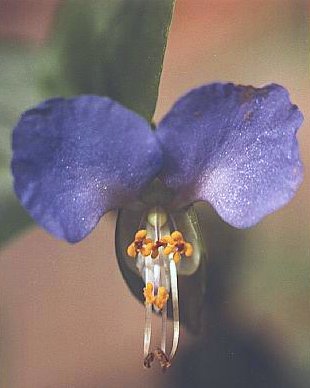
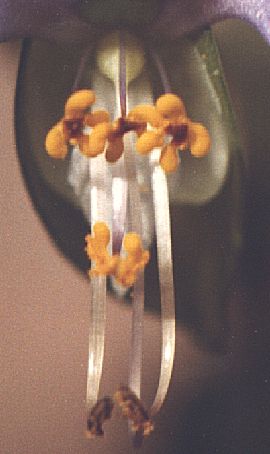
| Hierboven de bloem, sterk vergroot. Behalve de twee opvallende blauwe kroonbladen zijn ook de meeldraden erg mooi. De gelobde helmknoppen lijken heel kleine bloempjes op zich. Deze zijn ook slechts "versiering" om de aandacht te trekken van insecten, want alleen de twee onderste (minst opvallende) geven stuifmeel. | Above the flower, strongly enlarged. Apart from the two striking blue petals it also has lovely stamens. The lobed anthers almost seem tiny flowers in themselves. They're there only for "decoration" to draw insects' attention, only the two undermost (least striking) stamens bear pollen. |

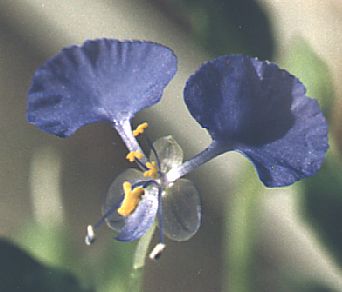
De Madeira-variant / The Madeira variation

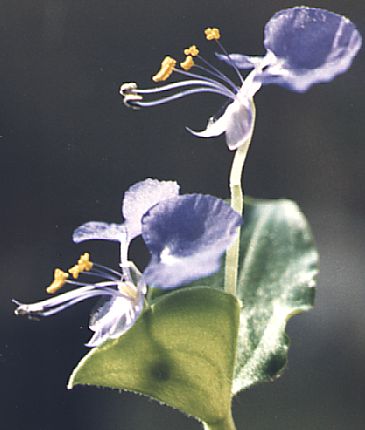
|
Hierboven de Madeirese ondersoort. Op de foto rechts is de lichte beharing te zien op het schutblad waaruit de bloem groeit. Uit elk schutblad komen kort na elkaar twee bloemen, de eerste is doorgaans uitgebloeid als de volgende zich opent, maar op bovenstaande foto's bloeien ze wel tegelijk. Op deze foto's is ook het derde, veel kleinere onderste kroonblad te zien, dat lichter blauw is en onopvallend. Daarachter zitten drie kleine min of meer vliezige kelkbladen. | Above the Madeira "subspecies". In the picture on the right you see the somewhat hairy bract from which the flower emerges. Within each bract two flowers grow, appearing shortly after eachother; the first one usually being past flowering when the second one opens, but in the pictures above they're open at the same time. In these photos also the smaller undermost petal is visible, lighter blue and inconspicuous. Behind it there are 3 small translucent sepals. |
